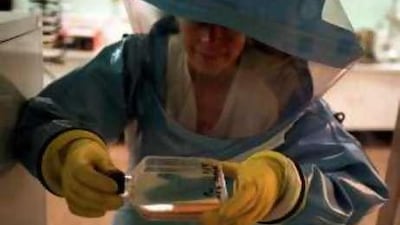When a Dutch tourist emerged from a forest cave in Uganda's Queen Elizabeth National Park last month, she unwittingly carried home a deadly souvenir in the form of one of the most terrifying viruses known to science. The first symptoms emerged a few days after she returned home: chills, fever - the usual signs of a viral infection. But within 48 hours she was hospitalised with far more sinister symptoms: liver failure and massive internal bleeding.
Tests revealed she had contracted Marburg haemorrhagic fever, a viral disease for which there is no cure and a fatality rate of up to 80 per cent. Within a week of admission to hospital she was dead. Investigations suggest she contracted the virus after being struck by one of the bats living in the cave. By any standards it was a nightmarish incident, and enough to make us all grateful for the remoteness of that bat-infested cave. Except it isn't - as upwards of 100 people have now discovered to their horror. They have been identified by medical researchers as having come into close contact with the Dutch woman during her return from Uganda.
All are now under surveillance for any sign that they have fallen victim to a deadly combination of the virus and a phenomenon which first made headlines a decade ago this month: the Small World Effect. In its most benign form, it's something we've all encountered. Talking to a total stranger at a party, we discover we've a friend in common - and exclaim "It's a small world!". Few of us give it a second thought; if we do, we might put it down to simple coincidence. Yet behind such apparently trivial events lurks a phenomenon able to bring even the remotest evils up close and personal.
The first hints of the power of the Small World Effect emerged from an experiment carried out over 40 years ago in research by an American psychologist. Stanley Milgram was investigating the networks of friends we all have, and devised an experiment in which random people were sent a package, together with instructions to deliver it to a specific "target". The twist was that Milgram did not include their precise postal address, but instead just their name and some vague clues about their whereabouts, occupation and age. Those taking part in the experiment were told simply to post the package to whichever of their own acquaintances were most likely to know the target.
Keeping track of the postings, Milgram made the stunning discovery that the packages typically reached their targets after passing through the hands of just five or so other people. In other words, everyone seemed connected to everyone else via a chain of just five or six intermediaries. The finding has since been replicated many times, and the explanation appeared almost exactly 10 years ago, in a now-celebrated paper published in the journal Nature. Two mathematicians at Cornell University, Duncan Watts and Steve Strogatz, used computers to simulate networks of virtual "friends", and then measured how many "handshakes" were typically needed to connect one friend to another elsewhere in the network.
At one extreme were utterly regular networks, where every friend only knew those right next to them. Devoid of any long range connections, these networks typically demanded lots of "handshakes" before one person could be connected to another. At the other extreme were utterly random networks, where people could have close connections with anyone else. Watts and Strogatz were most interested in what happened between these two extremes, in networks that were neither entirely regular, nor utterly random. They fully expected the number of handshakes needed to drop as the number of random links grew. But what they found was that just one tiny handful of such links was enough to short-circuit an otherwise huge network, turning it into a "small world". And the effect was dramatic: allowing just one in 100 people to have a random link to others in the network reduced the average number of handshakes needed to link people by a factor of 10.
Now it was possible to make sense of Milgram's findings. Among those involved in the re-postings were a few people with unusually varied selections of friends - and it was these who short-circuited the otherwise vast network of Americans. And it's the same type of people who trigger those "small world" links at parties. But the results do more than explain an amusing social phenomenon. They show how events in faraway places can affect us with unnerving speed. Most of us would never venture within a hundred kilometres of a dank, dark bat-infested cave - but some people do, and within a few days the miracle of air travel can deliver them into our midst. Fortunately, most will bring back nothing more horrific than some tales of destinations best avoided. Yet just one person can be enough to turn a rare viral infection into a mass epidemic.
Recent research suggests that the Aids virus spread to Haiti via a "small world" formed by businessmen travelling to and from Africa in the 1960s. At some point around 1969, one of the Haitians travelled to the US - forming its first link to the deadly small world of Aids in Africa. In 1967, Marburg virus first came to the attention of scientists following an outbreak in the eponymous German town. Staff at a local primate laboratory fell victim to the disease; seven died in horrific circumstances. Investigations revealed that they too had unwittingly created a small world - this time via monkeys brought to the laboratory from Uganda for vaccine research.
The Roman scholar Pliny the Elder once warned, "there is always something new out of Africa". The central lesson of the Small World Effect is that it will never stay there for long. @Email:www.robertmatthews.org

